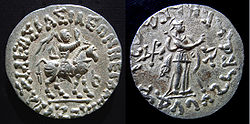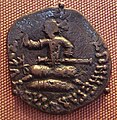Azes II
This article needs additional citations for verification. (January 2010) |
| Azes II | |
|---|---|
Indo-Scythian king | |
 Azes II in armour, riding a horse, on one of his silver tetradrachms, minted in Gandhara | |
| Reign | Scythians: perhaps 35–12 BC |
| Predecessor | Azilises |
| Successor | Zeionises/Kharahostes |
Azes II (
After the death of Azes II, the rule of the Indo-Scythians in northwestern India and Pakistan finally crumbled with the conquest of the
Name
Azes's name is attested on his coins in the Greek form Azēs (Ἄζης) and the Kharosthi form Aya (𐨀𐨩),[1] which are both derived from the Saka name *Aza, meaning "leader".[3]
Buddhist dedications
Bimaran casket
Azes II is also connected to the
Butkara stupa
A coin of Azes II was found under a pillar with an Indo-Corinthian capital and sculpture of a Buddhist devotee in the Butkara Stupa, suggesting the involvement of Azes II in Buddhist dedications, and a datation for the sculpture corresponding to the reign of Azes II.[4]
Coinage
Coins attributed to Azes II use Greek and Kharoshti inscriptions, depict a Greek goddess as his protector, and thereby essentially follow the numismatic model of the Greek kings of the Indo-Greek kingdom, suggesting a high willingness to accommodate Greek culture. A novel difference of the Indo-Scythians was to show the king on a horse, rather than his bust in profile as did the Greeks.
Other coins of Azes depict the
, suggesting religious tolerance towards his subjects. In the coin depicted to the left Azes is depicted with the inscriptions:
- Obv: King with coat of mail, on horse, holding a sceptre, with Greek royal headband. Greek legend ΒΑΣΙΛΕΩΣ ΒΑΣΙΛΕΩΝ ΜΕΓΑΛΟΥ ΑΖΟΥ "The Great King of Kings Azes".
- Rev: Kharoshti legend MAHARAJASA RAJADIRAJASA MAHATASA AYASA "The Great King of Kings Azes", with the Buddhist triratnasymbol in the left field.
Azes II was long believed to have issued several of the
Coin gallery
-
Portrait of Azes II
-
Coin of Azes II with Buddhist triratna symbol.
-
Coin of Azes II.
-
Coin of Azes II, with a clear depiction of his military outfit, with coat of mail and reflex bow in the saddle.
-
Coin of Azes II, with king seated, holding a drawn sword and a whip.
-
Seated king Azes II
-
Profile of king Azes II.
-
Coin
See also
- Ahir
- Ancient India and Central Asia
- Greco-Bactrian Kingdom
- Indo-Greek Kingdom
- Indo-Parthian Kingdom
- Kushan Empire
- Tillia tepe
- Yuezhi
Footnotes
- ^ JSTOR 43574181. Retrieved 2 October 2021.
- ^ a b Senior, R. C. (2008). "The Final Nail in the Coffin of Azes II". Journal of the Oriental Numismatic Society. 197: 25–27.
- ISBN 978-8-120-81408-0.
- ^ Handbuch der Orientalistik, Kurt A. Behrendt, BRILL, 2004, p.49 sig
- ^ Senior, R. C. (2008). "Azes: an unpublished and important tetradrachm S86.1T". Journal of the Oriental Numismatic Society. 197: 24–25.
- ^ Senior, R. C. (2001–2006). Indo-Scythian Coins and History. Lancaster, Pennsylvania: Classical Numismatic Group.
References
- The Shape of Ancient Thought. Comparative studies in Greek and Indian Philosophies by Thomas McEvilley (Allworth Press and the School of Visual Arts, 2002) ISBN 1-58115-203-5
- The Greeks in Bactria and India, W. W. Tarn, Cambridge University Press.









